DTGOV Cloud Migration: Evaluating AWS, Office 365, and IaaS Model
VerifiedAdded on 2023/04/21
|18
|1687
|347
Case Study
AI Summary
This case study examines the potential migration of DTGOV's web servers to the AWS cloud and the implementation of Office 365. It explores the benefits and issues associated with moving to Office 365, including scalability, collaboration, and security. The analysis differentiates between IaaS, PaaS, and SaaS cloud service models, recommending IaaS for SharePoint services due to its scalability and support for multiple users. The study also addresses potential problems with the IaaS model, such as data security and compliance, and provides recommendations for DTGOV to effectively implement IaaS, including establishing a robust security framework and estimating ROI. References to various sources are included to support the analysis and recommendations.

Migration of web servers of
DTGOV
Name of the Student
Name of the University
DTGOV
Name of the Student
Name of the University
Paraphrase This Document
Need a fresh take? Get an instant paraphrase of this document with our AI Paraphraser
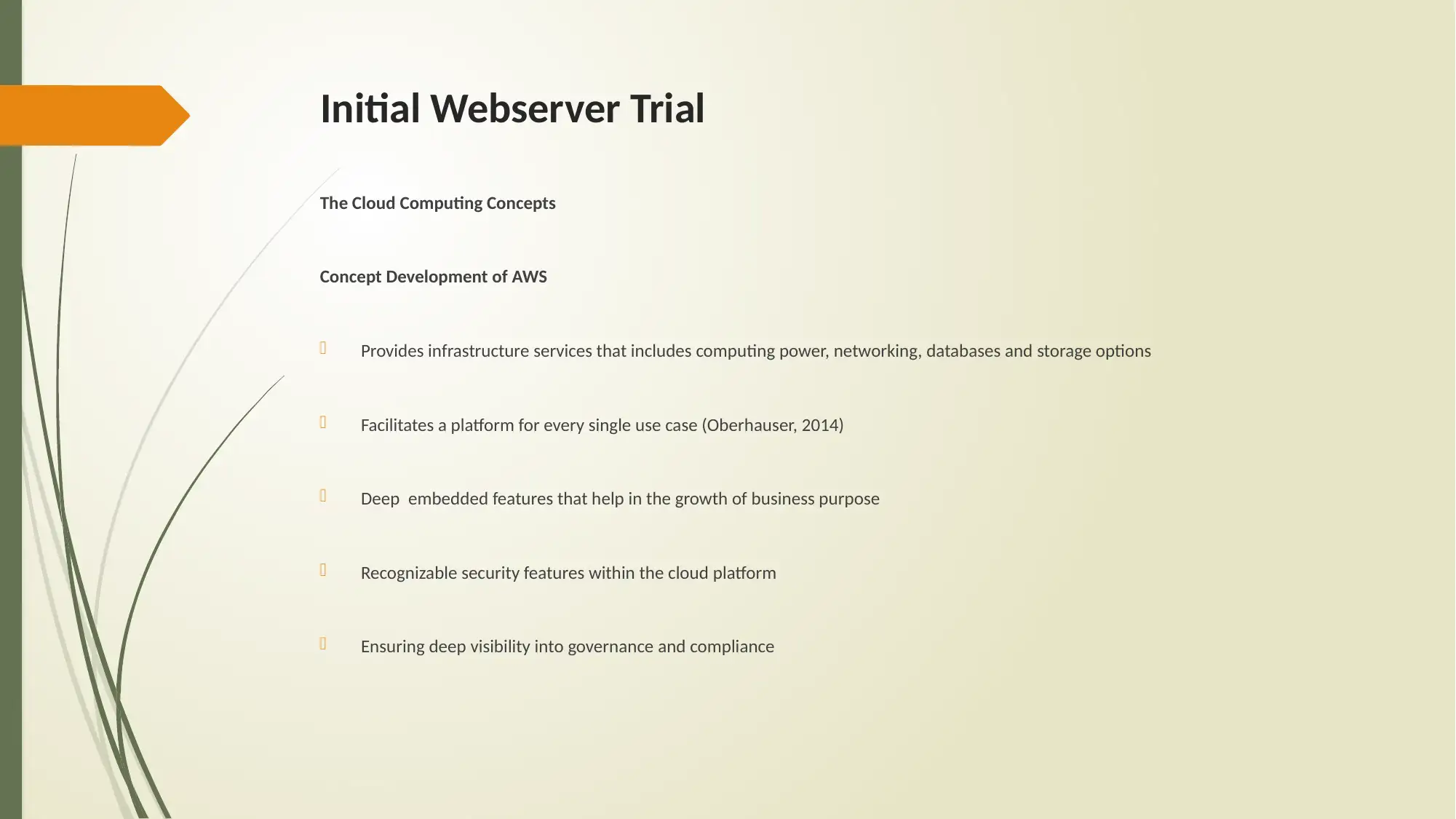
Initial Webserver Trial
The Cloud Computing Concepts
Concept Development of AWS
Provides infrastructure services that includes computing power, networking, databases and storage options
Facilitates a platform for every single use case (Oberhauser, 2014)
Deep embedded features that help in the growth of business purpose
Recognizable security features within the cloud platform
Ensuring deep visibility into governance and compliance
The Cloud Computing Concepts
Concept Development of AWS
Provides infrastructure services that includes computing power, networking, databases and storage options
Facilitates a platform for every single use case (Oberhauser, 2014)
Deep embedded features that help in the growth of business purpose
Recognizable security features within the cloud platform
Ensuring deep visibility into governance and compliance

Initial Webserver Trial
The Cloud Computing offered features by AWS:
The AWS Cloud environment would support the IaaS instance for serving the webservers of DTGOV
The AWS community would offer flexibility to build and support the application services (Usmonov et al., 2017)
The AWS community would also provide mobile based solutions, website support, backup of business data and recovery feature
The AWS cloud would offer analytics, database, application, global compute, storage and deployment services
The Cloud Computing offered features by AWS:
The AWS Cloud environment would support the IaaS instance for serving the webservers of DTGOV
The AWS community would offer flexibility to build and support the application services (Usmonov et al., 2017)
The AWS community would also provide mobile based solutions, website support, backup of business data and recovery feature
The AWS cloud would offer analytics, database, application, global compute, storage and deployment services
⊘ This is a preview!⊘
Do you want full access?
Subscribe today to unlock all pages.

Trusted by 1+ million students worldwide
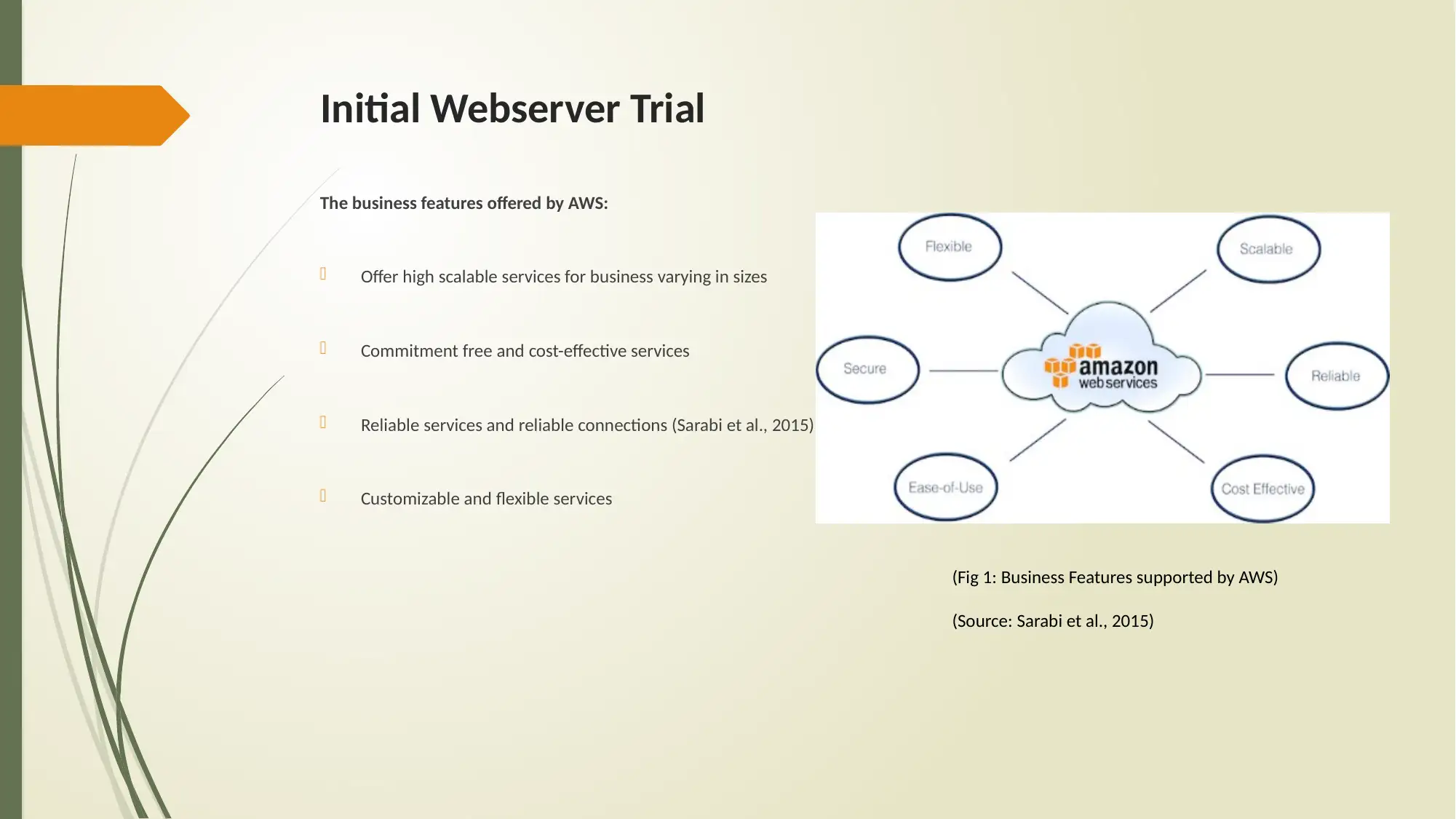
Initial Webserver Trial
The business features offered by AWS:
Offer high scalable services for business varying in sizes
Commitment free and cost-effective services
Reliable services and reliable connections (Sarabi et al., 2015)
Customizable and flexible services
(Fig 1: Business Features supported by AWS)
(Source: Sarabi et al., 2015)
The business features offered by AWS:
Offer high scalable services for business varying in sizes
Commitment free and cost-effective services
Reliable services and reliable connections (Sarabi et al., 2015)
Customizable and flexible services
(Fig 1: Business Features supported by AWS)
(Source: Sarabi et al., 2015)
Paraphrase This Document
Need a fresh take? Get an instant paraphrase of this document with our AI Paraphraser

Initial Webserver Trial
Types of Cloud Architectures useful for DTGOV:
Load Balancing
Amazon Cloud-Front
Elastic Load Balancer (Villamizar et al., 2016)
Security Management
Amazon RDS
(Fig 2: Representation of AWS Architecture)
(Source: Villamizar et al., 2016)
Types of Cloud Architectures useful for DTGOV:
Load Balancing
Amazon Cloud-Front
Elastic Load Balancer (Villamizar et al., 2016)
Security Management
Amazon RDS
(Fig 2: Representation of AWS Architecture)
(Source: Villamizar et al., 2016)
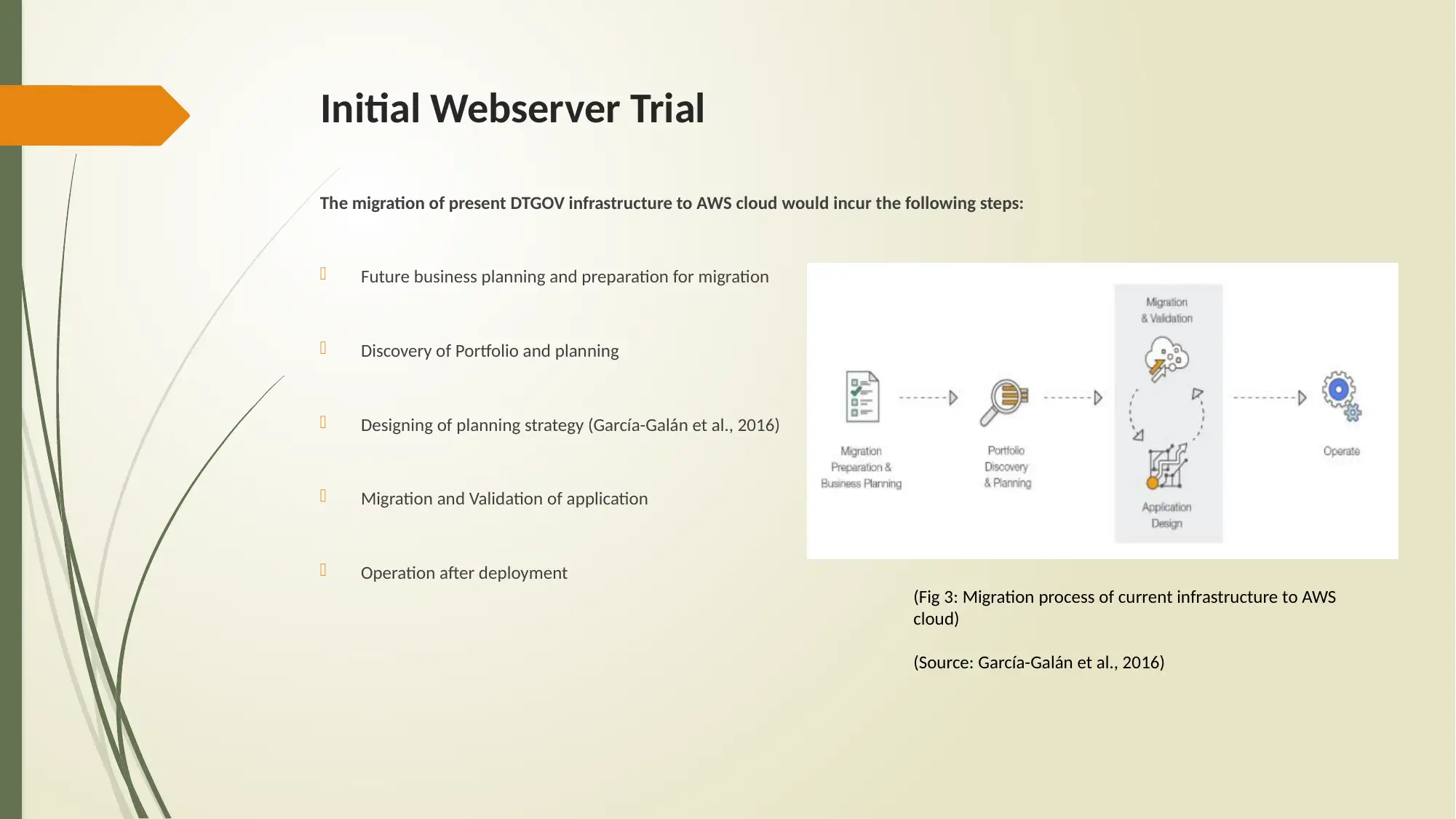
Initial Webserver Trial
The migration of present DTGOV infrastructure to AWS cloud would incur the following steps:
Future business planning and preparation for migration
Discovery of Portfolio and planning
Designing of planning strategy (García-Galán et al., 2016)
Migration and Validation of application
Operation after deployment
(Fig 3: Migration process of current infrastructure to AWS
cloud)
(Source: García-Galán et al., 2016)
The migration of present DTGOV infrastructure to AWS cloud would incur the following steps:
Future business planning and preparation for migration
Discovery of Portfolio and planning
Designing of planning strategy (García-Galán et al., 2016)
Migration and Validation of application
Operation after deployment
(Fig 3: Migration process of current infrastructure to AWS
cloud)
(Source: García-Galán et al., 2016)
⊘ This is a preview!⊘
Do you want full access?
Subscribe today to unlock all pages.

Trusted by 1+ million students worldwide
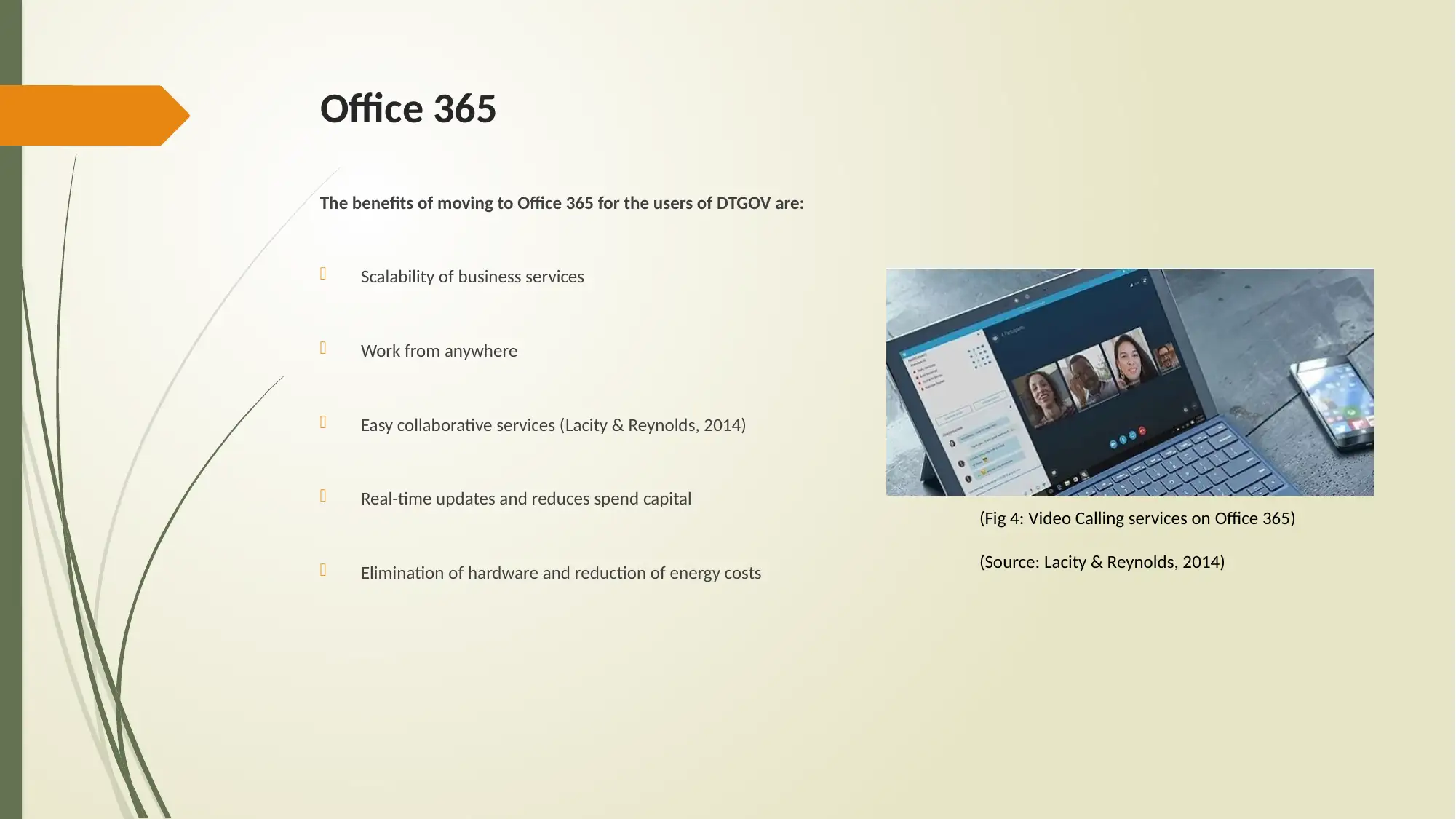
Office 365
The benefits of moving to Office 365 for the users of DTGOV are:
Scalability of business services
Work from anywhere
Easy collaborative services (Lacity & Reynolds, 2014)
Real-time updates and reduces spend capital
Elimination of hardware and reduction of energy costs
(Fig 4: Video Calling services on Office 365)
(Source: Lacity & Reynolds, 2014)
The benefits of moving to Office 365 for the users of DTGOV are:
Scalability of business services
Work from anywhere
Easy collaborative services (Lacity & Reynolds, 2014)
Real-time updates and reduces spend capital
Elimination of hardware and reduction of energy costs
(Fig 4: Video Calling services on Office 365)
(Source: Lacity & Reynolds, 2014)
Paraphrase This Document
Need a fresh take? Get an instant paraphrase of this document with our AI Paraphraser
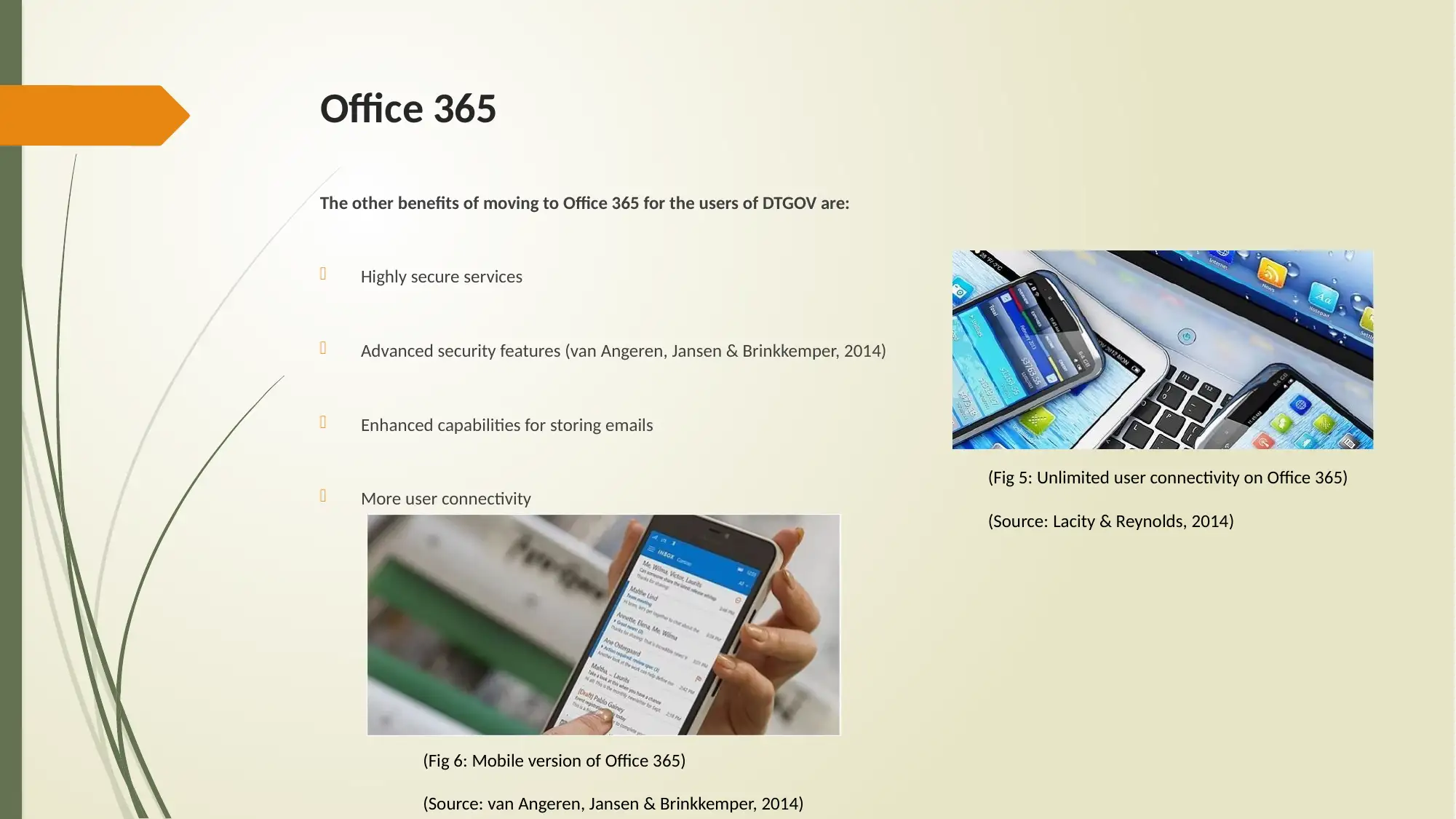
Office 365
The other benefits of moving to Office 365 for the users of DTGOV are:
Highly secure services
Advanced security features (van Angeren, Jansen & Brinkkemper, 2014)
Enhanced capabilities for storing emails
More user connectivity
(Fig 5: Unlimited user connectivity on Office 365)
(Source: Lacity & Reynolds, 2014)
(Fig 6: Mobile version of Office 365)
(Source: van Angeren, Jansen & Brinkkemper, 2014)
The other benefits of moving to Office 365 for the users of DTGOV are:
Highly secure services
Advanced security features (van Angeren, Jansen & Brinkkemper, 2014)
Enhanced capabilities for storing emails
More user connectivity
(Fig 5: Unlimited user connectivity on Office 365)
(Source: Lacity & Reynolds, 2014)
(Fig 6: Mobile version of Office 365)
(Source: van Angeren, Jansen & Brinkkemper, 2014)
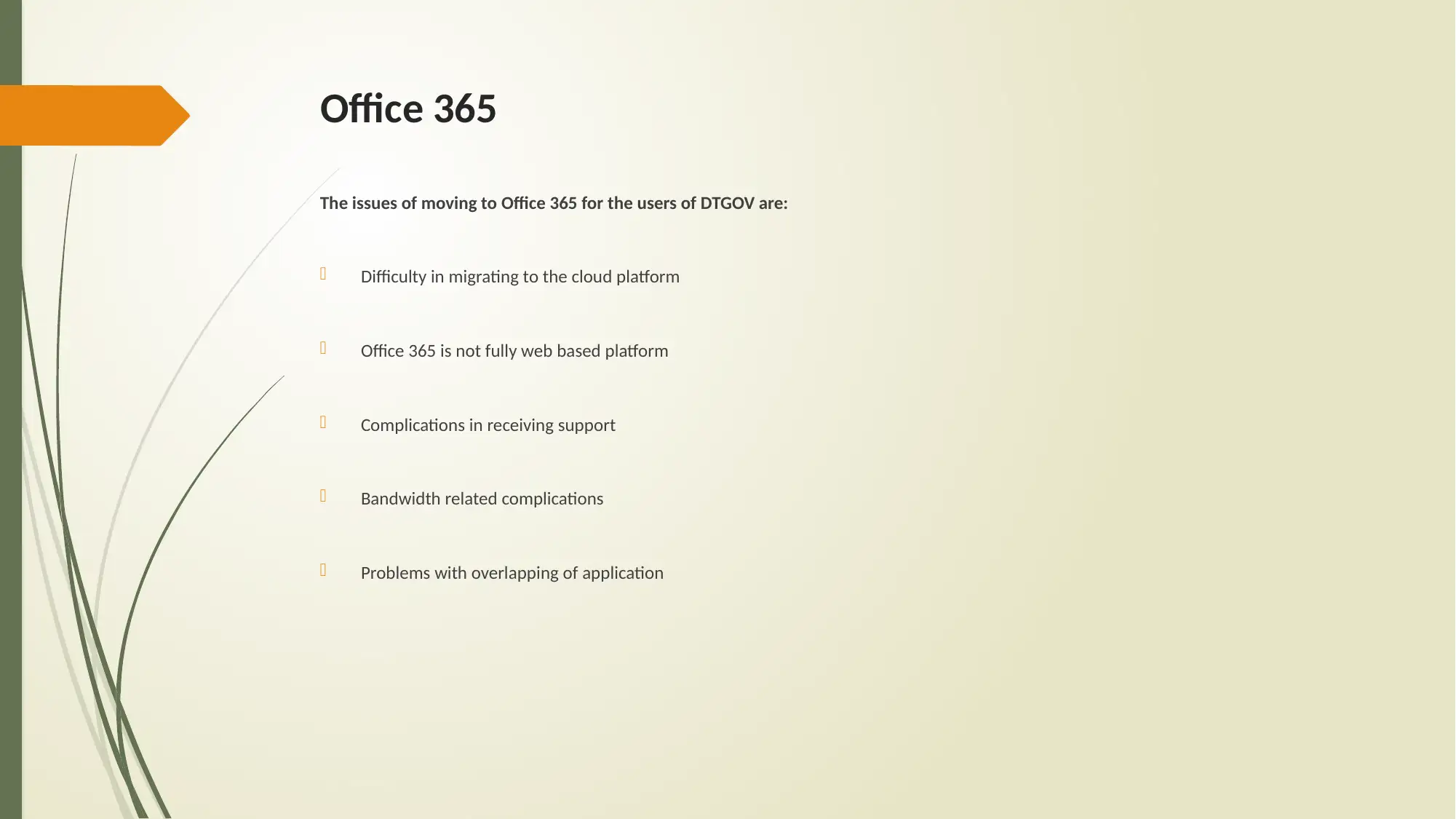
Office 365
The issues of moving to Office 365 for the users of DTGOV are:
Difficulty in migrating to the cloud platform
Office 365 is not fully web based platform
Complications in receiving support
Bandwidth related complications
Problems with overlapping of application
The issues of moving to Office 365 for the users of DTGOV are:
Difficulty in migrating to the cloud platform
Office 365 is not fully web based platform
Complications in receiving support
Bandwidth related complications
Problems with overlapping of application
⊘ This is a preview!⊘
Do you want full access?
Subscribe today to unlock all pages.

Trusted by 1+ million students worldwide

Implementation of a Cloud Approach
The implications of a cloud based approach from implementing the Office 365 suite is:
Continuity of Business Operations
Efficiency in collaboration (Rittinghouse & Ransome, 2016)
Flexibility within the practices of work
Access towards automatic updates
Scalable services
(Fig 7: Different Cloud based services)
(Source: Rittinghouse & Ransome, 2016)
The implications of a cloud based approach from implementing the Office 365 suite is:
Continuity of Business Operations
Efficiency in collaboration (Rittinghouse & Ransome, 2016)
Flexibility within the practices of work
Access towards automatic updates
Scalable services
(Fig 7: Different Cloud based services)
(Source: Rittinghouse & Ransome, 2016)
Paraphrase This Document
Need a fresh take? Get an instant paraphrase of this document with our AI Paraphraser

Differences between IaaS, PaaS and SaaS
The differences between IaaS, PaaS and SaaS are:
IaaS – They provide automated deployment of computing, storage and different other kind of networking services. A virtual
data center can be created and equipped with resource capabilities.
PaaS – This cloud service operates at lower level in comparison to SaaS. They also provide a platform that could be created
and launched (Kavis, 2014).
SaaS – They provide services at greatest level of abstraction. The cloud services enables users to connect and make use of
cloud based applications.
(Fig 8: The IaaS, PaaS and SaaS services)
(Source: Kavis, 2014)
The differences between IaaS, PaaS and SaaS are:
IaaS – They provide automated deployment of computing, storage and different other kind of networking services. A virtual
data center can be created and equipped with resource capabilities.
PaaS – This cloud service operates at lower level in comparison to SaaS. They also provide a platform that could be created
and launched (Kavis, 2014).
SaaS – They provide services at greatest level of abstraction. The cloud services enables users to connect and make use of
cloud based applications.
(Fig 8: The IaaS, PaaS and SaaS services)
(Source: Kavis, 2014)
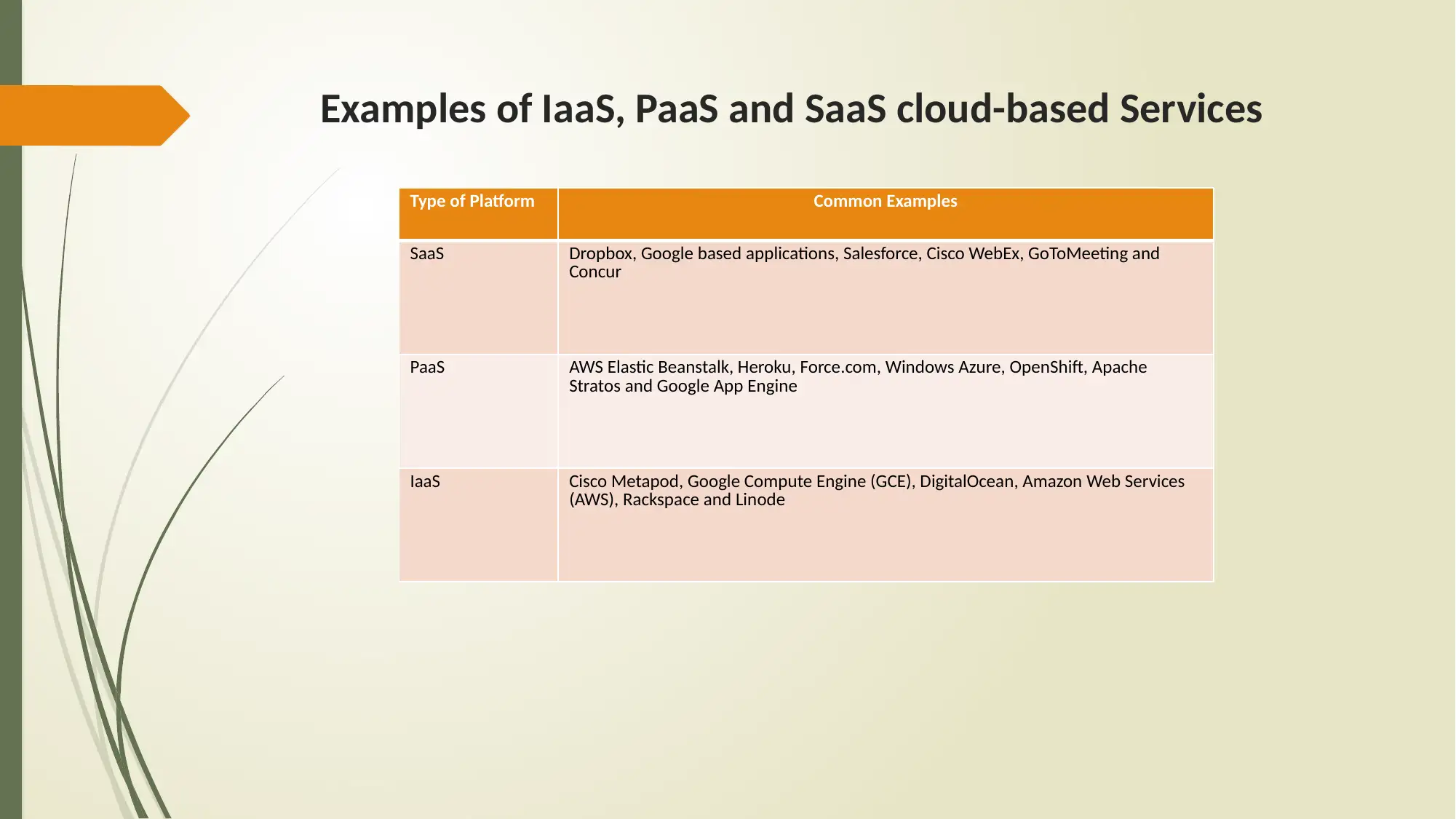
Examples of IaaS, PaaS and SaaS cloud-based Services
Type of Platform Common Examples
SaaS Dropbox, Google based applications, Salesforce, Cisco WebEx, GoToMeeting and
Concur
PaaS AWS Elastic Beanstalk, Heroku, Force.com, Windows Azure, OpenShift, Apache
Stratos and Google App Engine
IaaS Cisco Metapod, Google Compute Engine (GCE), DigitalOcean, Amazon Web Services
(AWS), Rackspace and Linode
Type of Platform Common Examples
SaaS Dropbox, Google based applications, Salesforce, Cisco WebEx, GoToMeeting and
Concur
PaaS AWS Elastic Beanstalk, Heroku, Force.com, Windows Azure, OpenShift, Apache
Stratos and Google App Engine
IaaS Cisco Metapod, Google Compute Engine (GCE), DigitalOcean, Amazon Web Services
(AWS), Rackspace and Linode
⊘ This is a preview!⊘
Do you want full access?
Subscribe today to unlock all pages.

Trusted by 1+ million students worldwide
1 out of 18
Related Documents
Your All-in-One AI-Powered Toolkit for Academic Success.
+13062052269
info@desklib.com
Available 24*7 on WhatsApp / Email
![[object Object]](/_next/static/media/star-bottom.7253800d.svg)
Unlock your academic potential
Copyright © 2020–2025 A2Z Services. All Rights Reserved. Developed and managed by ZUCOL.





